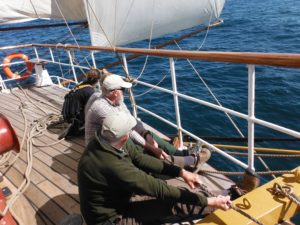Friday, September 1, 2017
The evening before the tenth right whale known to die in the Gulf of the Saint Lawrence was found, I took this photograph of a rainbow in Lark Harbor, Bay of Islands, Newfoundland. Our ship, Europa, was anchored less than five miles from Cedar Cove where the deceased right whale was found.
Cedar Cove is at the end of the road from Deer Lake, past Corner Brook, to Lark Harbor. The road the winds up the spruce-forested mountain to the right of the rainbow, around the high moorlands, down towards the place known for the best beach combing in Newfoundland, to end at Cedar Cove Trail Head Parking Lot. No one lives in Cedar Cove or on that side of the mountain.

August 2, 2017, Europa was off of Cedar Cove Newfoundland. South is to the right of the image. The shore ends at Bay of Islands. The tenth dead whale was found on this day on the shore to the right of the bowsprit. These are spacious seas where right whales roam.


The wind was very light from the north. In addition to the five square sails on fore and main masts, plus gaft-rigged mainsail on the mizzen, and staysails, big stunsails were set with clews pulled out on whisker poles, three above each other on either side of the foremast sails.

The day after discovery ship mates from Corner Brook told me of the whale’s death. Local knowledge was that ten right whales were feeding near the mouth of Bay of Islands, Newfoundland’s richest estuary.
Also this summer, researchers counted one hundred North Atlantic right whales near Prince Edward Island in the western portions of the Gulf of Saint Lawrence. Six right whales were found dead in this region and four right whales found dead on the western shore of Newfoundland. Not all of the whales were still identifiable. However, of those with markings, none of the Gulf of Saint Lawrence whales were individuals documented in the Gulf of Maine. The North Atlantic right whale population is reported to be 525, up from the former peak of 476 in 2013.
Genetic studies of the right whales calving off of Southeastern US found that when sampled again in summering areas only 60% of all known calves were with their mothers. The remaining 40% of calves were not observed on known summering grounds. Right whale paternity analysis found fathers of only 45% of known calves have been genetically determined. Since genetic profiles have been determined for 69% of all photo-identified males, the population of male right whales is likely larger than reported. Indications of additional whales that have never been documented by photographs and/or genetics suggests the existence of places for whales that have not yet been described.
Furthermore, while many whales are seen wintering off SE USA, nothing is known about the wintering grounds for much of the right whale population. We still have a lot to learn about where North Atlantic right whales dwell. We have yet to discover how many right whales dive and surface the North Atlantic. By all signs, there are very likely more than 525 whales living off our shores.
This is indeed good news. Fortunately, the death of ten right whales in the Gulf of Saint Lawrence this summer galvanized actions. Canadian authorities have mandated ships travel no more than ten knots and are lessening the amount of fixed fishing gear. There are plans to launch an underwater drone that will signal ships when right whales are nearby.
Meanwhile problems of pollution continue unabated, because only we can stop pollution.
Overall, life is looking good for right whales. With the knowledge of these majestic leviathans, we are better off as well.

I am more concerned with sperm whales of the NE Canyons and Seamounts National Marine Monument, as I explain in this short video.
The Ocean River Institute provides opportunities to make a difference and go the distance for savvy stewardship of a greener and bluer planet Earth. www.oceanriver.org